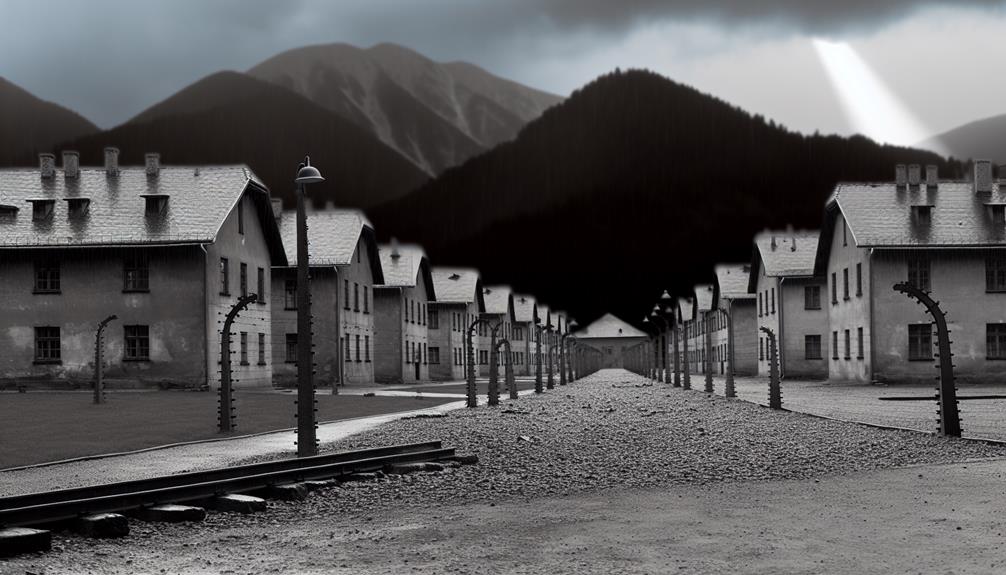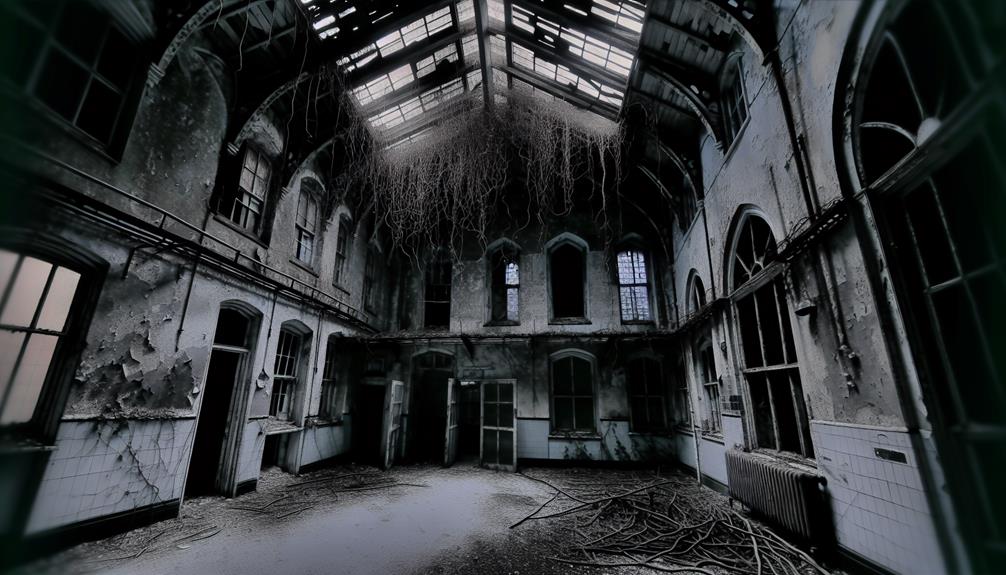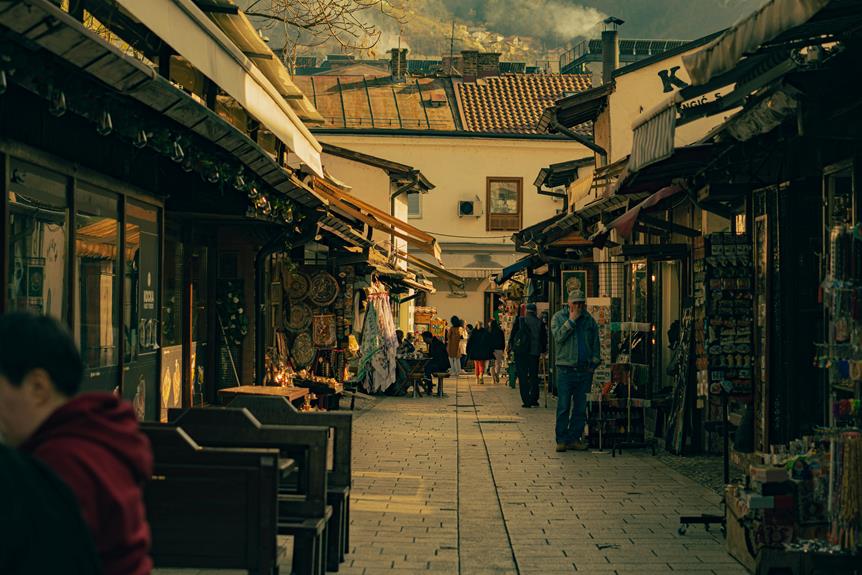Steeped in a history of sorrow and defiance, Mauthausen encapsulates Austria's complex narrative of oppression and resistance during one of humanity's darkest chapters. As the shadows of the past echo through its grim walls, the legacy of Mauthausen beckons us to explore the untold stories of courage and solidarity that unfolded amidst unspeakable horrors. The haunting whispers of the camp compel us to confront uncomfortable truths and ponder the lasting implications on the collective memory of a nation grappling with its past.
Key Takeaways
- Mauthausen camp symbolized Nazi oppression with grueling conditions.
- Inmates endured forced labor, malnutrition, diseases, and extreme punishment.
- Acts of defiance, sabotage, and preservation of cultural practices occurred.
- Liberation after WWII with a legacy of oppression and resistance.
- Impact on Austrian society, cultural memory, and lessons learned.
Establishment of Mauthausen Camp
During the dark era of World War II, the Mauthausen concentration camp was established in Austria in August 1938, becoming a symbol of inhumanity and suffering under the Nazi regime. The camp's infrastructure was designed to maximize control over prisoners and guarantee their systematic dehumanization. Situated near an abandoned stone quarry, Mauthausen was strategically chosen for its grueling conditions, intended to break the spirit of those interned within its walls.
The political significance of Mauthausen cannot be understated. As one of the first concentration camps established by the Nazis outside of Germany, Mauthausen served as a model for the network of oppression that would spread across Europe. Its location in Austria, annexed by Germany in 1938, symbolized the brutal enforcement of Nazi ideology in regions brought under their control. The camp's presence was a stark reminder of the regime's power and the horrors it inflicted upon those deemed undesirable.
The camp's infrastructure, characterized by its harsh living conditions, forced labor, and brutal treatment of inmates, reflected the systematic cruelty embedded within the Nazi regime. Mauthausen's political significance extended beyond its physical boundaries, serving as a tool of terror and control in the hands of the Nazis. The establishment of Mauthausen marked a dark chapter in history, illustrating the depths of human cruelty and the resilience of those who endured its horrors.
Conditions Inside the Camp
The stark and dehumanizing conditions inside Mauthausen concentration camp exemplified the extreme brutality and oppression experienced by its inmates under the Nazi regime. The survival conditions within the camp were harrowing, with inmates subjected to unimaginable horrors:
- Forced Labor: Inmates at Mauthausen were forced into back-breaking labor, primarily in the camp's granite quarry. They were made to perform grueling tasks for long hours with minimal food and rest, leading to physical exhaustion and mental anguish.
- Malnutrition and Disease: Inadequate food rations and poor living conditions resulted in rampant malnutrition and the spread of diseases among the prisoners. Many succumbed to illnesses due to the lack of medical care and proper sanitation facilities.
- Punishment and Cruelty: The camp guards exhibited extreme levels of inhumane treatment towards the inmates, inflicting physical and psychological abuse as a means of control. Any perceived disobedience or resistance was met with severe punishment, including beatings, public executions, and solitary confinement.
The inhumane conditions inside Mauthausen not only aimed to physically weaken the prisoners but also to strip them of their dignity and hope. Despite these challenges, stories of resilience and acts of solidarity among the inmates serve as a reflection of the human spirit's enduring strength in the face of adversity.
Prisoner Demographics and Nationalities
Prisoner demographics at Mauthausen concentration camp reflected a diverse array of nationalities, each contributing a unique perspective to the shared collective experience of oppression and survival. The camp housed individuals from various backgrounds, including Jews, political dissidents, homosexuals, Roma, and many others deemed undesirable by the Nazi regime. The sheer diversity of nationalities represented within the camp underscored the international scope of the atrocities committed during the Holocaust.
Survivors of Mauthausen have recounted harrowing tales of suffering, resilience, and solidarity. These survivor stories provide invaluable insights into the human spirit's capacity to endure unimaginable horrors and showcase the strength that can be found in unity. Despite facing extreme adversity, prisoners at Mauthausen often found solace in forming bonds with fellow inmates from different nationalities. This international solidarity served as a source of support and hope amidst the pervasive atmosphere of fear and despair.
The varied nationalities present in Mauthausen also highlight the need for remembrance and education to make sure that the atrocities committed during this dark period of history are never forgotten. By honoring the diverse backgrounds of those who suffered and perished at Mauthausen, we acknowledge the importance of preserving the memory of all victims and standing united against intolerance and oppression.
Daily Life and Survival Strategies
Amid the harsh conditions of Mauthausen concentration camp, inmates employed a range of resourceful strategies to navigate the challenges of daily life and enhance their chances of survival. The daily routines and survival tactics adopted by prisoners were essential in maintaining a semblance of normalcy and in resisting the dehumanizing effects of the camp environment.
Here are three key strategies that inmates utilized:
- Work Assignments:
Prisoners often strategically sought work assignments that provided access to additional food rations or less physically demanding tasks. Those assigned to jobs in the camp kitchen, for example, could sometimes supplement their meager meals with extra scraps or leftovers. Additionally, inmates who worked indoors were spared some of the brutal weather conditions and physical exhaustion endured by those working outdoors in quarries or construction sites.
- Bartering and Networks:
Inmates engaged in bartering goods and services with fellow prisoners, establishing underground networks to exchange items like clothing, medicine, or information. These networks not only facilitated the acquisition of essential resources but also served as a form of emotional support and solidarity in the face of extreme adversity.
- Mental Resilience:
Many prisoners found solace and strength in maintaining a sense of inner resilience and hope. Engaging in small acts of defiance, holding onto personal beliefs, or finding moments of camaraderie with others helped sustain their spirits amidst the daily horrors of the camp. Developing mental strategies to cope with the trauma and uncertainty of their situation became a crucial component of their survival tactics.
Acts of Resistance and Defiance
Within the confines of Mauthausen concentration camp, acts of resistance and defiance emerged as poignant expressions of human spirit amidst unimaginable suffering and oppression. In the face of extreme brutality, prisoners exhibited remarkable bravery and defiance, refusing to succumb to the dehumanizing conditions imposed upon them. Through clandestine acts of sabotage, secret gatherings to maintain a sense of solidarity, and the preservation of cultural practices, inmates demonstrated a resilience that defied the crushing weight of their circumstances.
Bravery manifested in various forms within the camp, from small acts of defiance such as sharing meager rations with fellow prisoners to larger acts of sabotage aimed at disrupting the camp's operations. Despite the constant threat of punishment or execution, individuals showed unwavering courage in standing up against their oppressors. Unity played a critical role in the resistance efforts, with prisoners supporting each other through shared experiences and a common goal of survival. This sense of solidarity helped to foster a collective spirit of defiance that inspired hope in the midst of despair.
The resilience displayed by inmates in Mauthausen serves as a tribute to the indomitable nature of the human spirit. In the face of unimaginable horrors, individuals found the strength to resist, defy, and persevere, leaving behind a legacy of courage that continues to inspire generations to come.
Liberation and Aftermath
Following the liberation of Mauthausen concentration camp, the harrowing aftermath unfolded, revealing the profound impact of the camp's atrocities on survivors and the world at large.
Key Aspects of the Aftermath:
- Rebuilding Communities: The survivors of Mauthausen faced the challenging task of rebuilding their shattered lives and communities. Many had lost family members, homes, and livelihoods during their internment, and the process of reconnecting with a world that had moved on proved to be a demanding endeavor. Support networks were vital in helping survivors navigate the complexities of post-camp life and in fostering a sense of belonging after the trauma they had endured.
- Psychological Trauma: The psychological scars left by the brutalities of Mauthausen ran deep. Survivors grappled with severe trauma, including survivor's guilt, nightmares, anxiety, and depression. The lasting effects of the dehumanization and violence experienced in the camp reverberated through their lives long after liberation. Mental health support and counseling became essential components in aiding survivors in coping with their emotional wounds and rebuilding a sense of self in the aftermath of such extreme trauma.
- Global Impact: The liberation of Mauthausen brought to light the extent of Nazi atrocities, shocking the world and underscoring the urgent need for international cooperation to prevent such horrors from recurring. The camp's liberation served as a stark reminder of the importance of human rights and the devastating consequences of unchecked hatred and discrimination, shaping global conversations on justice, accountability, and the protection of vulnerable populations.
Memorializing the Victims
In the aftermath of the liberation of Mauthausen concentration camp, the imperative to memorialize the victims with dignity and reverence became a profound and pressing undertaking for both survivors and the global community. Commemoration events play an important role in honoring the memory of those who suffered and perished in the camp. These events not only serve as a way to pay tribute to the victims but also aim to educate current and future generations about the atrocities committed during the Holocaust.
Educational programs are another significant aspect of memorializing the victims of Mauthausen. By incorporating the camp's history into school curricula and public awareness campaigns, societies can make sure that the memory of the victims lives on. These programs help foster empathy, understanding, and a commitment to never forget the horrors of the past.
Through commemoration events and educational programs, the global community can come together to remember the victims of Mauthausen and make sure that their stories are told with respect and accuracy. By actively engaging in these initiatives, individuals can contribute to preserving the memory of those who suffered at the hands of oppression and tyranny. It is through these collective efforts that we can aim to create a more compassionate and inclusive world, where the lessons of history are never forgotten.
Impact on Austrian Society
The legacy of Mauthausen concentration camp has left a profound impact on Austrian society, shaping collective memory and influencing societal attitudes towards remembrance and reconciliation. This impact on Austrian society can be understood through the following points:
- Social Impact: The existence of Mauthausen and the atrocities committed there have deeply affected Austrian social structures. The recognition of the horrors that occurred within the camp has sparked conversations about Austria's role during the Nazi era and its responsibility in addressing past injustices. This awareness has led to a reevaluation of societal values and a commitment to promoting tolerance and inclusivity.
- Cultural Memory: Mauthausen has become a central component of Austria's cultural memory. The stories of survivors and the victims who perished in the camp are now integrated into the national narrative, serving as a reminder of the consequences of totalitarianism and discrimination. Memorials, museums, and educational programs dedicated to preserving the memory of Mauthausen ensure that future generations understand the importance of upholding human rights and standing against oppression.
- Educational Initiatives: The impact of Mauthausen extends to educational initiatives aimed at fostering empathy and understanding among Austrians. Schools across the country incorporate lessons about the Holocaust and Mauthausen into their curricula, encouraging students to critically reflect on the past and actively engage in creating a more just and compassionate society. By confronting the dark chapters of history, Austrian society continues to work towards a future built on mutual respect and solidarity.
Lessons Learned and Never Forget
Etched into the fabric of Austrian history, the imperative to glean lessons from the horrors of Mauthausen transcends mere commemoration, embodying a profound commitment to never forget. The atrocities committed at Mauthausen during the darkest days of World War II have left a lasting impact on Austrian society, shaping its collective memory and sense of responsibility towards preserving the truth of the past.
The lessons learned from Mauthausen serve as a stark reminder of the consequences of unchecked hatred, discrimination, and authoritarianism. They underscore the importance of vigilance in safeguarding democratic values, human rights, and the dignity of every individual. By addressing the painful truths of the past, Austrians endeavor to create a more inclusive and compassionate society, where the mistakes of history are not repeated.
The commitment to never forget is a solemn promise to honor the memories of the victims, to educate future generations about the dangers of extremism, and to stand up against injustice in all its forms. It is a call to action for each member of society to uphold the values of tolerance, respect, and empathy, ensuring that the legacy of Mauthausen remains a guiding light towards a more just and peaceful future.
Legacy of Hope and Remembrance
Rooted in the solemn echoes of history, the enduring legacy of Mauthausen beckons as a beacon of hope and remembrance, guiding present generations towards a future built on compassion and understanding. This legacy of hope and remembrance is a proof of the resilience of the human spirit in the face of unimaginable suffering and serves as a poignant reminder of the importance of preserving collective memory.
Here are three key aspects that highlight the hopeful resilience and collective memory embodied by Mauthausen:
- Educational Initiatives: Through educational programs and guided tours, Mauthausen continues to educate visitors about the atrocities that occurred within its walls. By imparting knowledge and fostering understanding, these initiatives make certain that the legacy of Mauthausen lives on in the hearts and minds of future generations, inspiring them to stand against oppression and injustice.
- Commemorative Events: Regular commemorative events held at Mauthausen serve as a platform for collective remembrance, allowing individuals from diverse backgrounds to come together and honor the memories of those who suffered and perished. These events not only pay tribute to the victims but also strengthen the bonds of solidarity and empathy among attendees.
- Artistic Expressions: Artists from various disciplines often use their talents to depict the experiences of those who were imprisoned in Mauthausen. Through literature, music, visual arts, and other forms of creative expression, these artists contribute to the preservation of collective memory and offer a means of reflecting on the past while fostering hope for a more compassionate future.
Frequently Asked Questions
How Did the Local Community React to the Establishment of Mauthausen Camp?
In response to the establishment of Mauthausen camp, the local community exhibited a mix of reactions.
Some individuals showed community support by complying with the authorities, while others engaged in local resistance, expressing dissent and attempting to alleviate the suffering of those imprisoned.
These contrasting responses illustrate the complexity of human behavior in times of oppression and the diverse ways in which communities navigate challenging circumstances.
What Were the Psychological Effects on Survivors After Liberation?
After liberation, survivors of traumatic events like those at Mauthausen often experienced profound psychological effects. Post-traumatic stress disorder (PTSD) was common, characterized by intrusive memories, nightmares, and emotional numbness.
Survivor guilt, a feeling of responsibility for the suffering of others, weighed heavily on many who lived through the horrors of the camp.
These lasting effects underscore the deep emotional toll of surviving such horrific experiences.
Were There Any Instances of Collaboration Between Prisoners and Guards?
Survival strategies in concentration camps often involved maneuvering through complex power dynamics. Instances of collaboration between prisoners and guards could occur. While these collaborations were sometimes borne out of necessity for basic needs, they also highlighted the inherent complexities of human behavior under extreme conditions.
Understanding these dynamics sheds light on the multifaceted nature of survival strategies in such oppressive environments. The lines between victim and perpetrator could blur.
How Has the Legacy of Mauthausen Influenced Contemporary Austrian Politics?
The legacy of Mauthausen has profoundly influenced the contemporary Austrian political landscape. It has shaped national narratives, fostering a collective memory that emphasizes remembrance, education, and reconciliation.
The presence of this historical site serves as a poignant reminder of the atrocities committed during World War II, prompting ongoing discussions about human rights, tolerance, and the importance of safeguarding democratic values in modern-day Austria.
What Efforts Are Being Made to Preserve the Physical Structures of the Camp?
Preservation efforts at the Mauthausen concentration camp are vital due to its profound architectural significance as a stark reminder of historical atrocities. Various initiatives aim to maintain the physical structures of the camp, ensuring that future generations can witness the stark reality of its past.
Conclusion
In the shadow of Mauthausen's grim legacy of oppression, stories of resilience and defiance illuminate the darkness of humanity's capacity for cruelty.
The camp's impact on Austrian society serves as a reminder of the enduring importance of remembrance and the need to confront historical injustices.
Through acts of resistance and remembrance, we are called to ponder the past, honor the victims, and work towards a future where such atrocities are never repeated.


